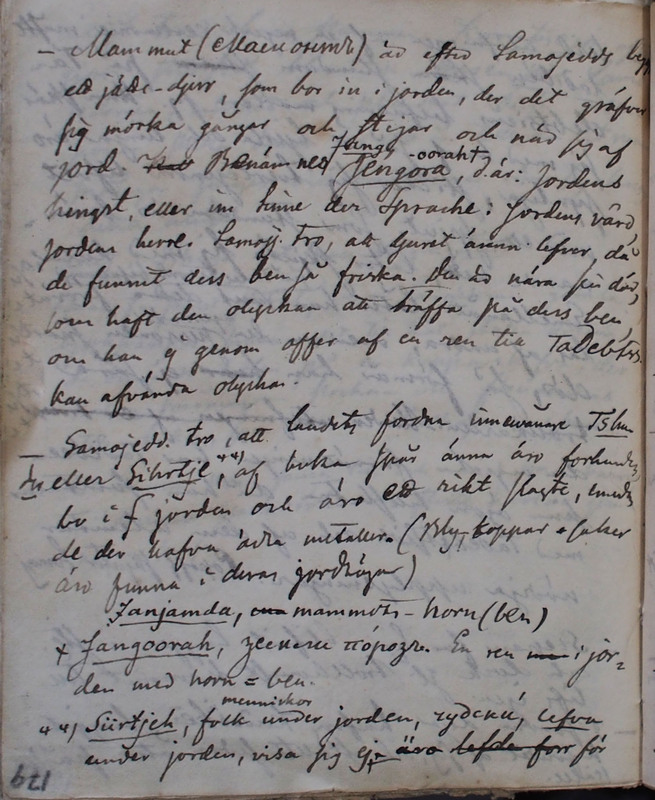Strödda ethnographiska anteckningar. 012
Title
Strödda ethnographiska anteckningar. 012
Description
| Mammut (мамонтъ) är efter Samojedds begr[epp]. ett jätte-djur, som bor in i jorden, der det gräfver sig mörka gångar och stigar och när sig af jord. Benämnes Jang, -oorah Jengora,
TN яʹ хора ʻmammoth’, literally ʻearth’s male [animal]’. This refers both to the mammoth findings the Nenets made and to a mythic being (Janhunen 2011; Lukin 2021; Arzyutov 2019).
«Jangoorah, земли порозъ. En ren i jorden med horn=ben.» d.ä, Jorderns hingst, eller ins Sinne der Sprache: Jorderns vård, Jordens herre. Samojj.[Samojeder] tro, att djuret ännu lefver då de funnit dess ben så friska. Den är nära sin död, som haft den olyckan att träffa på dess ben, om han ej genom offer af en ren till Tadebtss.[Tadebtsioh] kan afvända olyckan. |
The mammoth (mamontʹʹ) is, according to Samoyed conceptions, a giant animal which lives in the earth, where it digs itself dark passages and paths and lives by [eating] the soil. it is named Jengora «(Jang-oorah Jangoorah, zemli poroz''. A reindeer in the ground with antlers = bones)», in other words, Earth’s stag, or ins Sinne der Sprache: Earth’s host, Lord of the Earth. The Samoyeds believe that the beast is still alive, because they found its bones so fresh. Anyone who has had the misfortune to find its bones is close to death if he cannot avert the accident through sacrificing a reindeer to Tadebtsioh.
|
| Samojj.[Samojeder] tro, att landets fordna innevånare Tschu- di eller Sihirtje,
«Siirtjeh, folk menniskor under jorden, чудски, lefva See [siirtjeh].
under jorden, visa sig ej, äro lefda forr, för» af hvka[hvilka] spår ännu äro forhanden, bo i jorden och äro ett rikt slägte, emedan de der hafva ädla metaller. (Bly, koppar-saker äro funna i deras jordhöjnr.[jordhöjningar]). |
The Samoyeds believe that the country’s ancient inhabitants, the Tschudi or Sihirtje «(Siirtjeh, people underground, čudski; they live under the earth and do not appear)», of whom there are still traces available, live in the earth and are a rich tribe, because they have precious metals. (Lead, copper items are found in their elevations). |
|
Janjamda,
mammuth-horn (ben)TN яʹ нямд ʻmammoth tusk’, literally ʻearth’s horn’
|
Janjamda, mammoth-horn (bone) |

